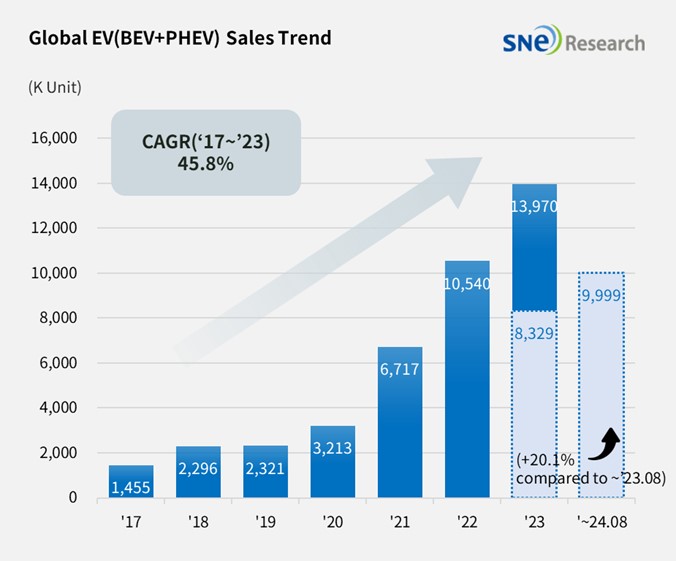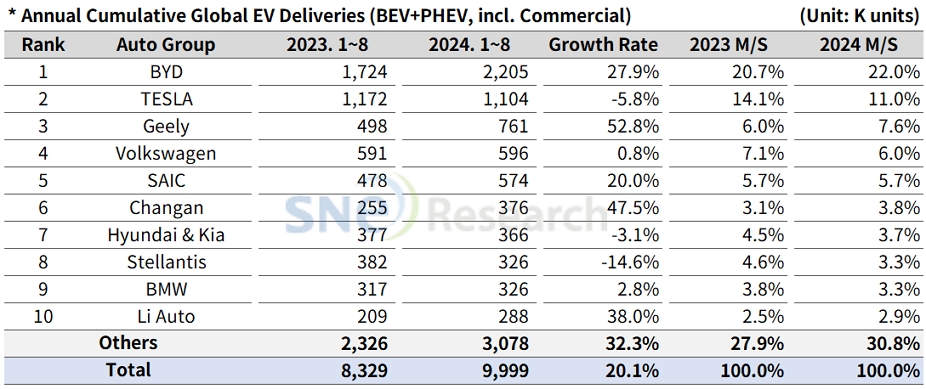From Jan to Aug 2024, Global[1] Electric Vehicle Deliveries[2] Posted Approximately 10 Mil Units, a 20.1% YoY Growth
- BYD stayed global No. 1 in the ranking, and European market posted a degrowth
From
Jan to August 2024, the number of electric vehicles registered in countries
around the world was approximately 10 million units, a 20.1% YoY increase.

(Source: Global EV and Battery Monthly Tracker – Sept 2024, SNE Research)
If we look at the global EV sales by major OEMs from Jan to Aug 2024, BYD took the global top position in the ranking by selling 2.205 million units and posting a 27.9% YoY growth. Favorable sales of BEV and PHEV line-ups, such as Song(宋), Seagull (海鸥), Qin(秦), Dolphin (海豚), and Yuan(元), have led the growth of BYD. The Chinese EV maker has been continuously expanding its market share by diversifying its brand portfolio through many sub-brands such as Denza (腾势), Yangwang (仰望), and FangCheong Bao (方程豹). BYD’s sales of BEV, excluding PHEV, was approx. 980k units, which almost reached a similar level as Tesla of which sales (1.104 million units) consist of 100% BEVs.
Tesla ranked 2nd on the list, posting a 5.8% YoY degrowth, with sales of its main models – Model 3 and Y, accounting for about 95% of the entire sales – declining. Tesla experienced a 16.2% YoY decrease in Europe and an 8.4% decrease in sales in North America.
The 3rd place was taken by Geely Group. ZEEKR 001, by Geely’s premium brand ZEEKR (极氪), and its light EV model, Panda (熊猫) Mini, were sold around 70k units respectively in the Chinese domestic market. In other markets than China, Geely Group has been rapidly expanding its global market share mainly led by Volvo and Polestar.

(Source: Global EV and Battery Monthly Tracker – Sept 2024, SNE Research)
Hyundai Motor Group sold approx. 366k units of electric vehicles, recording a 3.1% YoY degrowth. Although IONIQ 5 and EV 6 sold less than the same period of last year, the global sales of EV9 have expanded, and the delivery of newly launched EV3 to customers has started. In addition, as the sales of GM and VW in China have significantly declined, Hyundai is likely to benefit from them, instead. From the end of 2024, IONIQ 9 and EV 4 are scheduled to be launched in the US and Europe, leading to an expectation that Hyundai would rebound to an upward trend.

(Source: Global EV and Battery Monthly Tracker – Sept 2024, SNE Research)
By region, China, accounting for 62.6% of market share, firmly stayed No. 1 as the world’s biggest EV market. The global EV market growth was driven by China which was the only country to record more than 30% of growth compared to the same period of last year.
In Europe, the sales of BEV+PHEV posted a 2.7% YoY degrowth due to the deepening chasm phase, but the sales of HEV posted a 17.2% YoY increase. This has proven that the electrification trend has slowed down along with adjustments to the Euro 7 regulation. All of these are based on concerns about possible decreases in profit by the existing OEMs when EVs demand slow down.
In North America, where a seesaw game between the two Presidential candidates has continued, posted a 9.6% YoY growth. Despite the implementation of IRA, a slowdown in demand for EVs has not been solved, which seemed to lead OEMs to focus more on developing hybrids, instead.
Although major countries have tried harder to keep the Chinese EVs from entering their markets, China has been showing a high growth in the EV industry. The pace of transformation to electric vehicles is getting slower in other regions than China, instead. Major reasons behind such slow electrification can be; reduction in EV subsidy, high price of EVs, and shortage of EV-related infrastructure. While global major OEMs postponed the launch of new models or started internal restructuring, the Chinese OEMs have been expanding their presence in emerging countries based on the economy of scale. There are still more obstacles to tackle before overcoming the chasm phase, such as expansion of subsidy and infrastructure; securing the safety; and increasing the price competitiveness of electric vehicles made in regions other than China.
From the end of 2024 or beginning of 2025, it is expected that the EV market may see a slight increase in growth with new models launched in Europe and the US. In the US, Presidential candidate Harris’ approval rating has been increasing, and in Europe, the carbon emission control regulations were recently reinforced again and state subsidies for electric vehicles were resumed. All of these seem to be related to possible reinvigoration in the EV market next year. Plus, if tariffs against Chinese entry-level electric vehicles in Europe go down, the penetration rate of electric vehicle is expected to go further up.
[2] Based on electric vehicles (BEV+PHEV) delivered to customers or registered during the relevant period

